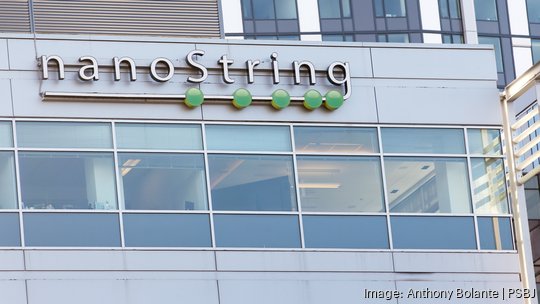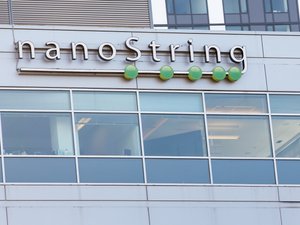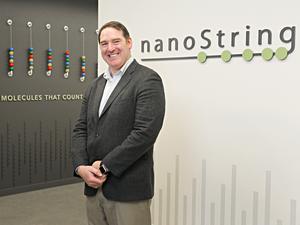
NanoString Technologies Inc.’s fortunes have tumbled during a series of legal challenges brought by competitor 10x Genomics Inc.
After going through multiple rounds of layoffs in recent months, Seattle-based NanoString filed for bankruptcy in February. A path forward emerged on March 10 when the research device company announced plans to be acquired by health care investment firm Patient Square Capital for $220 million. The deal needs approval from bankruptcy court, and a court hearing is set for March 28.
NanoString CEO Brad Gray called the bankruptcy filing “a direct result of the extraordinary campaign of litigation instigated by 10x Genomics,” which has sued NanoString in multiple courts over patent claims.
Patent litigation is a common and often costly affair in the tech world. Lawrence Graham, a patent attorney with Seattle-based Lowe Graham Jones, said the legal fees that often come with patent challenges can drain a company’s resources in the courts.
“It’s too often the case that the party on the other side wants to use the judicial system as a tool and drive up the cost because they have deeper pockets than you do. Maybe they want to use that to their advantage, and they’ll spend money irrationally knowing that you can’t,” Graham said. “There are enough things of that sort that you’re entitled to pursue that if you simply pursue those somewhat aggressively, it might look like you’re just trying to pursue the merits of your side and not trying to aggressively rack up the costs.”
The toll patent challenges can take on companies varies, Graham said, and many cases are not so painful. The majority of cases, he said, are settled before the court date.
But in some cases, it’s not just the defendants that are outmatched. A smaller company that feels a competitor is infringing on its patents often faces a costly and time-consuming road to seek justice, Graham said.
NanoString’s bankruptcy filing stopped all ongoing patent litigation against the company, which has since raised $47.5 million million in debtor-in-possession financing.
NanoString, founded in 2003, makes high-powered, high-tech imaging and research tools. Pleasanton, California-based 10x, a 12-year-old company, also makes imaging tools, as well as software and analysis tools. 10x has sued NanoString in the U.S., Germany and the European Union’s Unified Patent Court (UPC).
In November, 10x announced a jury in the U.S. District Court for the District of Delaware found in favor of 10x in a patent lawsuit, awarding 10x more than $31 million in damages. NanoString released a statement saying it plans to appeal the decision, a process that usually takes 12 to 18 months.
The UPC in September issued a preliminary injunction blocking sales of some NanoString products in the 17 UPC countries. In February, however, NanoString announced the UPC Court of Appeal had overturned the preliminary injunction. The case is awaiting a full hearing. A company spokesperson said NanoString will know more about future dates for the case once NanoString exits restructuring.
A 10x spokesperson in a statement at the time of the decision called NanoString’s win “a desperate attempt to prop up its financial interests as it navigates bankruptcy” and said that “NanoString’s repeated patent infringement continues to harm the scientific community.”
Gray previously told the Business Journal the NanoString revenue flow blocked in Europe represents about 10% of the company’s overall revenue. NanoString’s legal bills are “many millions of dollars,” he added, and that money would otherwise go into product innovation.
NanoString in January announced layoffs to about 50 employees. The company in October announced layoffs to about 110 employees. NanoString plans to complete its most recent round of layoffs by the end of March, after which it will have just over 500 employees.
NanoString generated $48.1 million in revenue during the third quarter, up from $29.5 million during the third quarter of 2022. The company hasn’t released financial results from the fourth quarter and full year of 2023.
10x, meanwhile, generated $184 million in revenue during the fourth quarter, up 18% year over year. It generated $618.7 million in revenue during 2023, up 20% from 2022. The company has also filed patent lawsuits against Cambridge, Massachusetts-based biotech Vizgen, Palo Alto, California-based Curio Bioscience and Seattle-based Parse Biosciences.
Allison Glasunow, a patent attorney focused on life sciences at Perkins Coie, said cases can take years and cost tens of millions of dollars, plus damages. Damages are frequently the remedy in life science cases given the court often doesn’t want to remove a treatment or device from the market.

Glasunow, who usually works with early-stage biotechs, said there are measures in place to deter erroneously wielding patent law as a weapon to crush competitors. For one, biotechs being sued will often try to invalidate the patents of companies suing them, so a company is unlikely to sue unless it feels its patents are valid. Plus, lawyers who instigate frivolous lawsuits can face disbarment, and the companies filing the lawsuits can also be punished.
“There would be quite a bit on the back end that they could be punished with if they were to do that,” Glasunow said.
As for how much protection bankruptcy affords a biotech being sued, Glasunow said it varies.
“It would really depend on what the court decided with respect to the damages that are owed,” Glasunow said. “It gets really, really complicated.”






